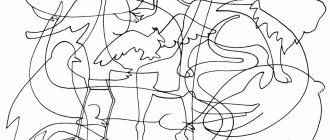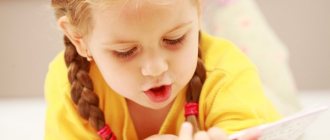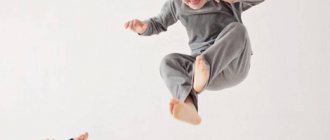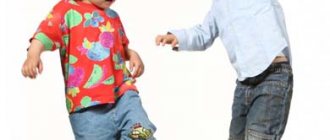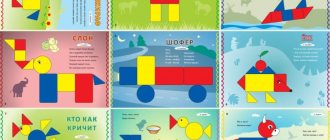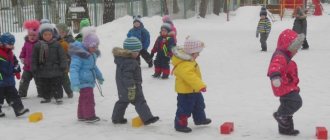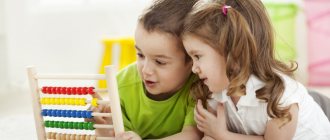An important part of the subject-development environment in the group room is the book corner. This thematic “center of the book” can play a significant role in shaping children’s sustained interest in books, the desire to read, and the need to learn new things.
In the publications presented in this section, teachers share their positive experience of creating beautiful, well-designed and functional book corners, and give useful advice on the aesthetic design of this part of the group’s subject-development environment.
Make the book corner the pride of your group!
Contained in sections:
- Book. All materials on the topic of books 6894
- Corners and centers in groups 6116
Showing publications 1-10 of 255. All sections | Book corner, center. Design examples
New
Photo
The best
Consultation for parents “How to organize a book corner in the family” A children’s book is a means of mental, moral and aesthetic education. Children's poet I. Tokmakova called children's literature the fundamental basis of education. Fiction shapes moral feelings and assessments, norms of moral behavior, educates...
Organization of a book corner in the first junior mixed age group
Reading fiction plays an important role in the development of children's cognitive and creative abilities. The main task of introducing preschool children to fiction is to cultivate interest and love for books, the desire to communicate with it, the ability...
Work assignments: we keep order in the book corner.
| 2. |
| Work |
Objectives: Teach children to carry out work assignments during the week as part of a group, highlight the front of work | distribute responsibilities, maintain order. Form a conscious attitude to order, responsibility for fulfilling work assignments.
| Socialization. Reading |
| 3. |
| Reading. Artistic creativity |
Preparation for the role-playing games “Chauffeurs” “Bus”: examination of illustrations on the topic “Chauffeurs”; reading the story by N. Kalinin “How the guys crossed the street”; game “Good Truck” (based on the fairy tale “The Brave Traveler” by A. Lopatin). Objectives: To develop the play activity of children, to familiarize them with basic generally accepted norms and rules of relationships with peers and adults. To form primary ideas about the work of adults, its role in society and the life of each person.
Reading nursery rhyme by T.A. Mavrina “Wicketwork”, looking at illustrations, drawing animals found in this work. Objectives: To draw children's attention to the means of expression used by the artist: technique, bright colors, large images of animals, the manner of creating a silhouette colored spot. Learn to convey images of animals and birds in drawings.
| Communication |
| 5. |
Exercise “Name the word.” Objectives: To develop the sound culture of speech, to update children’s knowledge of the sound composition of words. Teach them to select words with a certain sound, evaluate the correctness of their answer, correlating it with the task.
Project activity: project “Earth is our common home.”*
| Cognition |
Objectives: During the production of a model of Eurasia, systematize children’s knowledge. To develop design and research skills, to teach how to choose the most appropriate way of activity and to use it productively, to stimulate the development of cognitive abilities.
Morning. Walk
| 1. |
| Cognition |
Observation: puddles after frost. Objectives: To draw children's attention to the ice that has formed on puddles, to help formulate a conclusion about the relationship between ice formation and low air temperature. Suggest coming up with a way to check the statement: “Ice on puddles is fragile.”_____________________________________________
Outdoor game "Colors". Objectives: Organize a conversation to identify children’s understanding of the rules of the game. Offer to all the guys
| tell the rules together, complement each other’s statements, ask the children what the driver should do. Contribute to improving the performance of game actions. | |
| Communication | Didactic game "Tender names". Objectives: To teach children to create diminutive derivatives from the names of comrades, to compose speech structures with the resulting words. Form friendly relationships between children, develop empathy, decentralization. |
| Physical Culture | Exercise "Mirror". Objectives: Exercise children in walking in combination with other types of movements (squatting on a signal, lifting the right leg and clapping under it). Enrich children's motor experience and develop coordination of movements. |
| Work | Labor assignments: covering perennial plants with foliage. Tasks: Invite children to talk about the purpose of this work operation, select the necessary equipment, and distribute responsibilities. Foster love and respect for living nature. |
| Evening. Walk | |
| Cognition. Communication | Observation: chestnut in late autumn. Objectives: Expand children’s understanding of trees, teach them to recognize chestnut trees by their characteristic structural features, and identify the peculiarities of life in late autumn. Learn to write a story about what happens to a tree in different seasons. |
| Physical Culture | Outdoor game "Rabbits". Complication: players move along a gymnastic bench on all fours and overcome obstacles. Objectives: Teach children to perform play actions. Develop dexterity, courage, endurance, creativity and imagination in motor activities. |
| Physical Culture | Independent motor activity. Objectives: To teach children to independently organize outdoor games, find activities of interest, and use a variety of sports attributes in physical activity. |
| Evening. Group work | |
| Reading | Reading the poem by D. Kharms “The Cheerful Old Man.” Objectives: Introduce children to the work, offer to tell the story of the hero, highlight what is funny in his actions, characterize the emotions evoked by the poem. Develop a sense of humor and literary taste. |
| Music | Playing with singing “Guselki” (Russian folk song arranged by M. Iordansky). |
| 3. |
| Music |
Objectives: To teach children to perform a song in groups one by one, to use means of expression in accordance with the content of the song and the characteristics of the melody. Develop a sense of rhythm in dance improvisations.
Listening to the Russian folk song “You’re a head”, arranged by N. Rimsky-Korsakov. Objectives: To develop musical and auditory perceptions, musical and aesthetic consciousness. Activate and expand the vocabulary associated with determining the nature of a musical work.
| Socialization |
| 4. |
Role-playing game "Barbershop". Objectives: To develop in children the ability to plan and “judge the actions of the players, to use the attribute” To develop the ability to convey the features of a hairdresser’s work in game actions.
DAY 7
Morning. Group work
Reading the story by E. Nosov “How a crow got lost on the roof.”
| 1. |
| Reading |
Tasks: Invite children to listen carefully to the presentation in order to find answers to questions; the teacher is taught to convey inferences in speech. To instill in children a love of reading, to cultivate a caring attitude towards living beings.
| Work. Communication |
| 2. |
| Cognition |
Canteen duty. Objectives: Teach those on duty to independently organize their work and the self-service of other children. Learn to use polite words, formulate requests clearly and correctly, and be courteous.
Games with Lego: building according to plan. Objectives: Expand children's understanding of the capabilities of the designer, the options for buildings that can be built from it. Learn to create new designs based on familiar ones, and be creative.
Work in a corner of nature: changing the water in the aquarium. Objectives: To teach children to determine the well-being of aquarium smart fish by their behavior. To help establish the relationship between water pollution and deterioration in the health of fish. Develop observation, empathy and support the desire to be useful.
Preparation for the role-playing game “Builders”: ri
poking on the topic “My city”; reading the story by D. Chiard “About the One Who Has Three Eyes.”
| Work. Cognition |
| 4. |
| Socialization. Artistic creativity. Reading |
Objectives: To develop sociocultural competencies in children (possession of knowledge and experience in performing typical social roles, the ability to imitate actions
| sphere of labor relations), develop children's play activities. | |
| Artistic creativity | Manual labor: we are preparing an exhibition of autumn crafts. Objectives: To teach children to make crafts from natural and other materials, to compose compositions from them, using previously mastered techniques. Develop imagination, visual perception, cultivate hard work. |
| Cognition. Communication | Conversation about late autumn. Objectives: To clarify and supplement children’s ideas about this season of the year. Learn to write short stories about animals and plants, autumn natural phenomena. Help to identify the relationship between individual natural phenomena. |
| Morning. Walk | |
| Cognition | Observation: alder in November. Objectives: To expand children's understanding of the diversity of trees, to teach them to recognize alder among other trees by their light gray trunk and black cones that hang on old branches. Talk about seasonal changes occurring in the tree. |
| Communication | Didactic game “First syllable”. Objectives: To organize the use by children of the ability to divide words into syllables and highlight the first syllable. Teach them to correctly correct mistakes made by their comrades and explain their position. |
| Physical Culture | Outdoor game “Migration of birds”. Objectives: To contribute to the improvement of game actions, to develop the ability to compare one’s actions with the rules of the game, to learn to monitor one’s posture. |
| Socialization. Communication | Independent play activities of children. Objectives: To develop in children skills related to the communicative and regulatory functions of speech. Learn to act as organizers of game interaction. |
| Socialization | Role-playing game "Trip around the city." Objectives: Expand children’s understanding of their hometown, tell about memorable places, and introduce them to the role of a tour guide. Learn to take on a role and conduct role-playing dialogues. |
| Evening. Walk | |
| Cognition | Observation: “How do coniferous trees prepare for winter?” Tasks: Invite the children to examine the spruce branches and carefully remove the scales from the bud located at the tip of the spruce paw. Show how tightly the kidney is blocked with a resinous substance. To help draw a conclusion about how spruce prepares for the onset of cold weather. |
| Physical Culture. Health |
| 2. |
Healthy walking around the territory of the kindergarten. Objectives: To improve children’s ability to change the speed of movement, to facilitate the development of race walking techniques. Develop endurance, strengthen leg muscles, promote children's health.
| Physical Culture |
| 3. |
Outdoor game “Magic wand”. Objectives: To introduce children to the rules of the game. Improve the ability to correlate your actions with the actions of other players, the driver, and navigate in space. Develop reaction speed.
Evening. Group work
Work in the book corner: restoration of worn-out copies.
| 1. |
| Work |
Objectives: To organize the use of appropriate work skills by children. Learn to choose rational work methods and provide mutual assistance. To inculcate hard work and respect for books.
| 2. |
| Music |
Round dance game “Steep Mountain” (Russian folk song, arranged by M. Iordansky). Tasks:
To improve children's performance of play actions, to develop vocal and performing abilities, musical and aesthetic consciousness, and the need for music.
Preparation for the role-playing game “Sailors”: lesson “Travel around the country”; paper construction (binoculars, glasses); reading the story by A. Lyapidevsky “To the North”.
| Cognition |
Objectives: Enrich the plot by setting more complex gaming tasks for children. Create an atmosphere of creativity and trust, giving each child the opportunity to express themselves in preparation and during the game.
Individual work on FEMP: didactic game “Name the days of the week.”
| Socialization. Artistic creativity. Reading |
| 3. |
Tasks: Exercise children in naming the days of the week from any day, teach them to pronounce the names correctly, choose the number corresponding to the serial number of a specific day of the week
| Safety |
| 5. |
Conversation on the topic “Rules of conduct on the road.” Objectives: Consider various situations with children, discuss how to act in each of them, what rules must be followed, what rules are violated by the heroes of the situations under consideration.
DAY 8
Morning. Group work
Reading the poem by S. Gorodetsky “The First Snow”. Objectives: Discuss the content of the work with children, teach them to listen to the rhythm of the text, highlight expressive
| ny means. Help to feel the anticipation of the imminent arrival of winter. | |
| Work | Duty during class. Objectives: To teach children to perform duty duties efficiently and independently, to organize the work of other children. Learn to see the meaning of work, carry out work processes holistically - from goal setting to obtaining and evaluating results, and exercise self-control. |
| Cognition. Communication | Games with large building materials: constructing a three-deck passenger ship. Objectives: To teach children to apply their knowledge and design experience in the process of work, to look for rational solutions, to negotiate, to work collectively. Develop verbal imagination, dialogical speech. |
| Work | Work in a corner of nature: loosening the soil. Objectives: Discuss with children the essence and purpose of the process of loosening the soil, when it needs to be done and how. Develop appropriate work skills and cultivate a caring attitude towards plants. |
| Socialization | Role-playing game “Builders”: the plot is “Selection of building material and its delivery.” Objectives: To contribute to the enrichment of the game with new solutions (changes in attributes), to create conditions for creative self-expression. Develop play activities, introduce basic generally accepted norms and rules to relationships with peers and adults. |
| Cognition | Observation from the window: the first snow. Tasks: Invite children to tell what is happening outside the window, make assumptions about where the snow comes from. Draw a conclusion about the connection between snowfall and cold weather. |
| Physical Culture | Outdoor game "Crucian carp and pike". Objectives: Exercise children in performing game actions, teach them to compare their actions with the rules. Develop endurance, speed qualities, and help improve motor skills. |
| Morning. Walk | |
| Cognition. Communication | Observation: birch in November. Tasks: Invite children to look at a tree, tell how it prepares for winter, summarize and supplement the children’s answers. Learn to write a short story based on the results of a series of observations. |
| Cognition | Didactic game "Who's first?" Objectives: To teach children to visually assess the length, draw a segment of a certain length by eye |
| Physical Culture |
| 3. |
in two parts. Develop visual perception, eye measurement, learn to formulate the results of work.
Outdoor game "Colors". Complication: players need to move in a half-squat with a heel-to-toe roll in a gymnastic step. Objectives: To develop in children the ability to compare their actions with the rules of the game, to teach them to use the knowledge of colors and shades in the game, to monitor their posture and movement time. Develop attention, coordination of movements, dexterity, creativity in motor activity.
| Physical Culture |
| 4. |
| Cognition. Communication |
Exercise "Circus performers". Objectives: To train children in jumping over a long rope, to improve the performance of basic movements, to enrich motor experience. Develop leg muscles, endurance, agility.
Evening. Walk
Observation: spruce and pine needles. Tasks: Invite children to compare spruce needles and spruce needles, characterize their color, length, features of position on the branches. Activate in speech and clarify relevant concepts. Learn to compose a short description story using speech constructions of comparison and contrast._____
| Physical Culture |
| 2. |
Exercise “This is how I can!” Objectives: Exercise children in jumping over a large handle used as a jump rope. Develop dexterity in the calf muscles.________________________________
| Physical Culture |
| 3. |
Outdoor game "Stop". Objectives: Contribute to the improvement of action games, develop the ability to compare your actions with the rules of the game; learn to monitor your posture
Evening. Group work
| 1. |
| Cognition |
Work in the sensory education corner. Objectives: To teach children to examine objects and determine their various properties using different organ senses. Strengthen the ability to record your impressions in speech.
| 2. |
| Music |
Round dance game “Trees” (Russian folk song arranged by M. Iordansky). Tasks:
Teach children to perform game actions, sing a song that characterizes the tree, the name of which the child has chosen. Develop creative activity in song improvisations.
Role-playing game "Sailors". Objectives: To promote the creative use of game ideas about the surrounding life, skills.
| I. " | pick up items and attributes for the game, use substitute items. | |
| Communication | Individual work on speech development. Objectives: To train children in the use of nouns in the genitive case, in the plural, to teach them to use them correctly in various speech constructions. | |
| Socialization. Cognition | Designed according to the design from the building material "Lego". Objectives: Develop creativity, learn how to build collectively, use previously mastered skills and abilities to realize the plan. Form the habit of tidying up your workspace after games. | |
| DAY 9 | ||
| Morning. Group work | ||
| 1, I | Reading | Reading works of children's choice. Objectives: Teach children to choose a book for collective reading, motivate their choice, answer questions about the content of a familiar book. |
| Work. Cognition | Working in a corner of nature: growing green food. Objectives: To teach children to grow green food for the inhabitants of a corner of nature, to independently determine what needs to be planted and when. Cultivate responsibility, hard work, observation, and caring attitude towards the environment. Learn to evaluate the results of work and share your impressions. | |
| I. | Cognition | Games with building materials: building bridges. Objectives: Teach children to use their skills to build various buildings. To consolidate ideas about the purpose and general structure of bridges. Learn to observe the principles of proportionality, symmetry, stability. |
| Cognition. Communication | Working in a corner of nature: looking at the album “Animals of Africa”. Objectives: Continue to introduce children to the animals of Africa, invite them to look at the drawings, characterize the features of the appearance and vital functions of various animals. Develop coherent speech, develop the ability to establish a relationship between the structure and characteristics of the life of animals. | |
| V. O. | Socialization. Work | Role-playing game "Mail". Objectives: Invite children to play out various situations, acting as postal workers. Learn to choose optimal behavior patterns and convey in the game the features of a postman’s work. |
| Socialization | Independent play activity. |
| 7. |
| Health |
Objectives: Offer children printed board games; during observation, track the extent to which the children understand the rules and essence of the games, how diligent they are, and their desire to complete the game.
Conversation on the topic “Cleanliness and Health.” Objectives: To form in children ideas about the importance of compliance with sanitary and hygienic standards for health, about microbes as the cause of some diseases.
Morning. Walk
| 1. |
| Cognition |
Observation: aspen in November. Tasks: Invite the children to look at the tree, guess what happens to it in late autumn. Show the children how tightly and securely the aspen buds are covered, remove several rows of scales from them and examine the earrings. P' be able to draw conclusions about how trees prepare for winter.
Didactic game “What is where?”
| 2. |
| Cognition |
Objectives: To teach children to designate with words the position of objects in relation to themselves, to enrich their vocabulary, to teach them to choose from a synonymous range of concepts that most accurately characterize the position of an object
| Socialization |
| 3. |
Game activities based on children's interests. Objectives: To develop independence and activity in children, to develop the ability to spend leisure time interestingly and usefully.
| Physical Culture. Health |
| 4. |
Outdoor game "Mirror". Objectives: To train children in running, to teach them how to perform various movements correctly (running with high knees, small and wide steps, straight legs, etc.). Expand motor experience, increase the functionality of the body__________________________________________
Evening. Walk
| 1. |
| Cognition Physical culture. Health |
| 3. |
Observation: larch and juniper. Tasks: Invite children to examine plants, compare the structure of trunks, branches, leaves, using tactile capabilities for inspection. Help create a comparative story, summarize the results of the observation._________________________________________________
Independent motor activity of children. Objectives: To develop health-preserving competencies (a positive attitude towards one’s health, knowledge of methods of physical self-improvement, emotional self-regulation, variety of motor experience, the ability to use it). Teach children to select sports attributes for various types of physical activity. _________________________________
Outdoor game “Magic wand”.
| Objectives: Teach children to act in accordance with the rules of the game. Develop attention, memory, speed of reaction, endurance. | |
| Evening. Group work | |
| Cognition | Individual work on FEMP. Objectives: Exercise children in ordinal counting within 20, teach them to correctly pronounce ordinal numbers, and include them in various speech structures. |
| Music | Playing with singing “Oh, I got up early” (Russian folk song arranged by N. Metlov). Objectives: Teach drivers to dramatize a song performed by a children's choir. To promote the development of children's creative activity in the transmission of musical images. |
| Socialization | Role-playing game "Firemen". Objectives: Teach children to convey the labor actions of firefighters in a game, offer to play out the situation “Training of firefighters.” Develop creative imagination and the ability to develop a game together. |
| Music | Song creativity: work with the song “Lullaby”, music by V. Agafonnikov, words by A. Shibitskaya. Objectives: Teach children to compose melodies based on a model on a given topic. To develop a modal sense, the ability to emotionally distinguish the modal functions of melody sounds, to feel the emotional expressiveness of pitch movement. |
| Physical Culture | Work in the physical education corner: learning to throw the ball. Objectives: Organize repetition of the rules of safe behavior with the ball in the group. Exercise children in throwing the ball to each other with their right (left) hand and catching it with both hands. Develop the eye, improve motor skills. |
| DAY 10 | |
| Morning. Group work | |
| Cognition. Reading | Observation: heather flowers. Reading the poem by A. Barto “For flowers in the winter forest.” Objectives: Invite children to examine the heather, talk about the features of the appearance and vital functions of this plant. Invite the children to guess how to care for the heather. |
| Socialization | Role-playing game "Staff Police". Tasks: Teach children to play together, prepare the environment for the game, select attributes. Work to develop and enrich the plot of the game. |
| Socialization | Conversation “...I’ll teach my little brother how to put on shoes!” Objectives: To form sociocultural competencies (possession of knowledge and experience in performing typical tasks |
| Health |
| 4. |
cial roles; the ability to act in everyday situations in the family and everyday sphere, to determine one’s place and role in the surrounding world, in the family, in a team; mastery of cultural norms and traditions lived in one’s own activities). Teach to understand the dependence of good relationships in a team on the personal qualities of each person.
Exercise “My Appearance”. Objectives: To strengthen children’s ability to use individual personal hygiene items (handkerchief, comb, towel), and to monitor their appearance. Foster a hygienic culture, create a conscious need for cleanliness._____________________________________________
| Artistic creativity |
| 5. |
Drawing on the theme “Russian folk costume”. Objectives: Continue to introduce children to decorative and applied arts, consolidate ideas about the features of Russian folk costume, and develop the ability to decorate clothes with various details. Develop aesthetic taste.
Working in a corner of nature: learning to maintain order.
| 6. |
| Labor Cognition |
Objectives: Discuss with children what work actions need to be performed regularly to maintain order in the corner, teach them to use rational work methods._____________
Morning. Walk
Observation: trolleybus and bus. Objectives: Teach children to identify significant similarities and differences between vehicles, talk about the results of observations, and use information from personal experience.
| Physical Culture |
| 2. |
Outdoor game "Two Frosts". Objectives: To teach children to correctly perform game actions and the rules of the game. Develop dexterity, speed of reaction, coordination of movement.________________________
| 3. |
| Labor Physical education |
Work assignments: collecting fallen leaves. Tasks: Organize the collection of leaves for making crafts, herbarium, group decoration, consolidate children's knowledge about trees and shrubs. To form an interest in the aesthetic side of the surrounding reality, to teach to see the beauty of nature.
Exercise “Gymnastic balance beam”. Objectives: Exercise children in walking with side steps to the right and left along a log. Develop leg muscles, attention, coordination of movements, promote the formation of correct posture.
| Cognition | Didactic game “What has changed?” Objectives: To train children in determining the spatial arrangement of objects. Develop observation skills, introduce memorization techniques, and activate your vocabulary. |
| Physical Culture | Sports game football (played on the veranda). Objectives: To organize children’s further development of the elements of football, to teach how to dribble the ball around the pins, and how to hit a simulated goal. Improve the technique of dribbling the ball, develop creativity in motor activity. |
| Evening. Walk | |
| Cognition. Communication | Observation: evening sky. Tasks: Invite children to characterize the changes that occur in the evening, tell how the sky changes. Learn to use epithets, figurative expressions, and see the beauty of nature. |
| Physical Culture | Exercise “Jump, Jump.” Objectives: Exercise children in jumping on two legs over various objects. Develop flexibility of the knee joints, increase the functionality of the body. |
| Physical Culture | Relay game “Running with a ball”. Objectives: Teach children to perform movements at a fast pace and follow the rules of the competition. Develop speed, agility, build self-confidence, and help strengthen the body. |
| Work | Work assignments: cleaning the site. Objectives: Teach children to determine what needs to be done to restore order in accordance with the season of the year, weather conditions, and what equipment is needed. Foster hard work, create a work culture, teach people to act together. |
| Evening. Group work | |
| Health | Conversation on the topic “Dangerous invisible people.” Objectives: Invite children to reproduce the most important rules of hygiene, tell what their violation leads to, consider various situations, suggest what can happen to those who wash their hands irregularly or poorly. |
| Reading | Reading M. Voloshin’s poem “In Autumn”. Objectives: To teach children to listen to poetic lines, to see descriptions of seasonal changes in nature in works of art. Cultivate a love of nature and poetry. |
| Music | Listening to musical works by P.I. Tchaikovsky “Russian Song”, “Morning” from the “Children’s Album” cycle. |
Objectives: To teach children to compare musical works of different nature, to develop the ability to hear and express the changing moods of music in rhythmic movements.___________
Preparation for the role-playing game “Library”:
| Socialization. Reading |
| 4. |
a conversation about how books are created; reading the book by I. Ilyin and E. Segala “Stories about what surrounds you.” Objectives: To promote the improvement and diversification of children’s play ideas and skills. Stimulate the need to organize role-playing games.
Work in the music education corner: learning to play the Russian folk melody “I went up the hill” on the metallophone.
| 5. |
| Music |
| Cognition. Reading Socialization. Reading Socialization |
Objectives: To teach children to correctly convey the melody and rhythmic pattern of the work. Develop a musical-rhythmic sense, the ability to actively experience music, feel the emotional expressiveness of a musical rhythm and accurately reproduce it.
DAY 11
Morning. Group work
Observation from the window: snow in November. Objectives: To introduce children to Russian folklore that conveys signs associated with the first snow. Concretize the meaning of proverbs. For example, “From the first snow to the sleigh ride is six weeks.” Offer to check certain signs, discuss with the children how this can be done.______
Preparation for the role-playing game “Atelier”: conversations about the atelier, its purpose, about the people working in the atelier, about the social significance of their work; reading the poem by A. Barto “My Bear”. Objectives: To expand ideas and enrich children’s play experience on this topic, to teach them to convey the content of play roles in a new way. Develop the emotional sphere of children.
Conversation on the topic “Our Motherland Russia!” Objectives: To develop in children an understanding of citizenship and patriotic feelings. Learn to determine your place and role in the world around you, in the family, in the team, in the state. Form initial ideas about your native country.
Exercise “My locker”. Objectives: To develop self-service skills, teach children to keep their locker clean and tidy, and to correctly perform appropriate work actions. Develop a conscious attitude towards order, teach how to take care of personal belongings.___________________________
| Artistic creativity | A conversation about how the artist G.D. Pavlishin came up with drawings for the Nanai fairy tale “Mergen and his friends.” Objectives: To develop focus of visual perception in children. To develop the ability to see the features of the artist’s manner (decorativeness, stylization of the image of trees, flowers, animals and birds, contour and silhouette of the image). |
| Cognition | Work in a corner of nature: observing plants. Tasks: To form educational and cognitive competencies: teach to plan and analyze cognitive activity; ask questions to observed facts, look for the causes of phenomena, indicate your understanding or misunderstanding in relation to the problem being studied ⇐ Previous2Next ⇒
Individual and group automatic drinking bowls: for animals. Schemes and designs... Single-post wooden support and methods for strengthening corner supports: Overhead line supports are structures designed to support wires at the required height above the ground, water... Transverse profiles of embankments and coastal strips: In urban areas, bank protection is designed taking into account technical and economic requirements, but special importance is given to aesthetic... |
| © cyberpedia.su 2017-2020 — Not the author of the materials. The exclusive right is reserved by the author of the text. If you do not want this material to appear on our site, please follow the link: Copyright Infringement. We will help you write your work! |
Book corner, center. Design examples - Our book corner. Photo report
Publication “Our book corner...”
A book corner is a necessary element of a developing subject environment in a group room of a preschool institution. This is a form of disseminating information about books, their authors and illustrators, helping children get used to the image of a book, arousing interest in it, desire...
Image library "MAAM-pictures"
Book corner in early childhood group
In the Rainbow early childhood group, we have created a book corner in which children can independently choose books and calmly look at them. The book corner turned out to be cozy and attractive. It is located away from where children play, so that noisy games do not distract the child, good…
Basic requirements for the design of book corners
Fiction reveals to the child the main secret of life - he is not alone in this world: what worries him, cared for his ancestors, worries his contemporaries, will care for his children and grandchildren. A book corner is a necessary element of a developing subject environment in a group...
Group book corner
“Book corner of the “Romashka” group” V. Sukhomlinsky said: “Reading in childhood is primarily the education of the heart, the touch of human nobility to the innermost corners of a child’s soul.” Preschool childhood is a very important stage in raising an attentive, sensitive reader...
